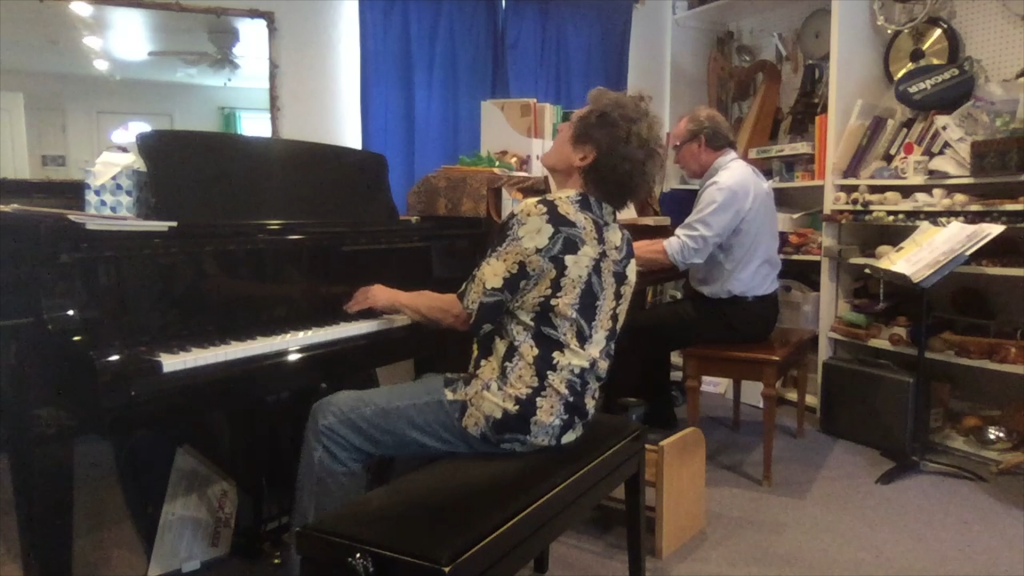
Last November, I asked one of my students to allow me to control their computer via Zoom. With permission from her parent, I installed Jamulus on her computer, and I initiated a connection to software that I’d started on my computer. We played together a Christmas duet that she was learning, in real-time. We could follow each other’s timing, and I could hear when she needed help in her rhythm or notes.
It was the first time I’d played a duet with a student since March, when we had started teaching via Zoom. I quietly cried while playing along; I had not realized how much I’d missed performing with my students.
In my last post, I talked of the tools I use to teach remotely, and I highlighted the limitations of audio with Zoom or CleanFeed – the two tools I usually use. I have craved the ability to play collaboratively, in real-time, with my students. Below I highlight some of what I’ve learned during my exploration of tools designed to enable musicians to perform together virtually.
Jonathan Best is a composer, pianist, and performer who is a local celebrity. Years ago, he moved to Prescott from NYC. There he was a studio pianist and vocalist, he ran a recording studio, he gigged all over the area, and he toured with David Byrne. In Prescott, his band Horned Beetle is the funkiest band in town. He plays with many other local musicians, can run a one-manned show, and has founded Commusikey, a non-profit grounded in the belief that all humans are musical.

Every Wednesday morning, Jonathan and I get together to philosophize and play together. During the past 8 months, we have spent much of our time experimenting with technologies that enable musicians to perform together remotely and in real-time. Whether we’re funking out on the blues, grooving on strange scales like the Octatonic, or indulging in free-improvisation, latency quickly becomes an issue. Like me, Jonathan has been on a quest to improve the real-time capabilities of remote teaching and collaborative performing.
Before I try any new technology with a student, I first test it with Jonathan. I owe a tremendous debt of gratitude to Jonathan for what I’ve learned in experimenting with real-time collaborative software and hardware.
I must note that I have never successfully gotten any of my students’ Windows computer to run any of this advanced software. Most Windows computers lack the audio drivers needed for real-time music collaboration. Also, none of the functional tools work on portable devices such as iPhones or iPads. Finally, I’ve only had success with students using cable Internet. My highest success comes with students running on MacBook computers, using an external mic and wired headphones, and (if possible) being wired directly to the router.
Jamulus
In Prescott, the best (and so far only) option for playing along with a student is a tool called Jamulus, the tool I mentioned above. On my MacBook Pro, I can run the Jamulus Server, which serves as the mastermind for allowing us to play together. Both the student and I then run the Jamulus client. We spend a little time tweaking our settings, and we find that we can play close to in-time with each other.
Sound quality is sacrificed. There are a lot of crackles and drops, but Jamulus does its best to keep the timing accurate. This works best if both the student and I are wired to our Router (and not using WiFi). Set up is straightforward: I ask the student to share their screen during a Zoom session, I download and install the software on their computer (they have to be there to hit a few Confirm buttons), and I tweak the settings as we get our system running.
I attempted to set up a central and public server for Jamulus in the Prescott area for area musicians, teachers, and students to use. In theory, if I could find a place in Prescott with low latency to the rest of the area (e.g., Prescott College’s latency to me and others is only 10ms), we could open up collaborative performances to a wider audience. Unfortunately, I have found no options. I did try a server in Phoenix, only to discover that data from Prescott to Phoenix routes to Phoenix, then to Los Angelas, and finally back to Phoenix before hitting any Phoenix area servers. Until I do find a local location for a server for the Prescott community, I have purchased a small Raspberry Pi computer (less than $100) and set it up as a dedicated Jamulus server on my home network, just for me and my students.
I’ve tried a lot of other tools, and here’s a quick rundown of my experience with them.
JackTrip
I’ve spent a fair amount of time with JackTrip. I have purchased an “inexpensive” standalone and low-latency JackTrip Virtual Studio Device. Using JackTrip with this device is easy, but the cost is more than my students would want to pay. The user interface is confusing and missing key elements such as audio level indicators. In addition, the audio components are less than pro-level. However, this device doubles as a Jamulus client, so I use this to minimize my Jamulus latency to as low as possible.
Using JackTrip on a computer itself is a mysterious, complicated, and unreliable process not worth trying. However, I believe that if I lived in a big-city with great Internet, JackTrip would allow me to enjoy fairly high quality and low-latency collaborative experiences. (Anybody in the Prescott area with a JackTrip Virtual Studio Device is invited to reach out to me to run tests and play together!)
SonoBud, SoundJack, and JamKazam
SonoBus looks like a promising and somewhat polished app for iOS that allows for real-time collaboration. However, my experiences with it on my iPad (again, wired to the router) are that latencies might start off as adequate, but they quickly devolve into unusable. I read of other peoples’ success with it, but I’ve yet to find that. There is an active and encouraging support group of users. SonoBus is still in beta, and if it evolves into a stable product for me, it may become a useful and easier-to-use tool for my students.
SoundJack.eu aims to make realtime collaboration easy. Its setup is a bit more convoluted than using Jamulus, but that is not an insurmountable obstacle for use with students. However, I found it less stable than Jamulus and without any noticeable improvement in quality or latency.
JamKazam is an older commercial tool that has ramped up its development since the pandemic. Last I tried it, it was unstable, and again, no better than Jamulus.
Aloha by Elk
I have often wondered why a big-name company like Yamaha hasn’t developed a professional, remote collaborating tool. The market for a reliable and high-quality tool for enabling collaborative performances over the Internet is no doubt tremendously large. I think I understand why not. From my experimentation, I’ve come to the conclusion that there are too many wildcards involved in sending real-time data over the Internet. What big-name company would want to risk releasing a product where more likely than not the audio quality that is possible is far from professional?
Still, being the optimist that I am, I have hope for one company’s upcoming product: Aloha by Elk. I am encouraged on two fronts. First, this is a reputable company with experience in realtime audio. Being from an established business differentiates it from all of the above tools. Most of the solutions I’ve experimented with are open source or research projects that all miss the refinement that an experienced company knows is critical to a product’s success. Second, this company is taking advantage of a new technology that may minimize some of the latency issues we experience with traditional ISPs: cellular 5G. I do not know enough to speculate if 5G could be a solution that avoids the pitfalls of ground-based Internet, but I’m signed up for the Beta program. With any luck, I might be able to report on them sometime in the future.
Until then, I’ll keep encouraging my students to invest in a quality Internet connection and, if possible, a MacBook. With any luck, my student of today (who has a brand new MacBook Air) will soon upgrade from DSL to Cable Internet.
One thought on “Seeking Duets in a Virtual World”